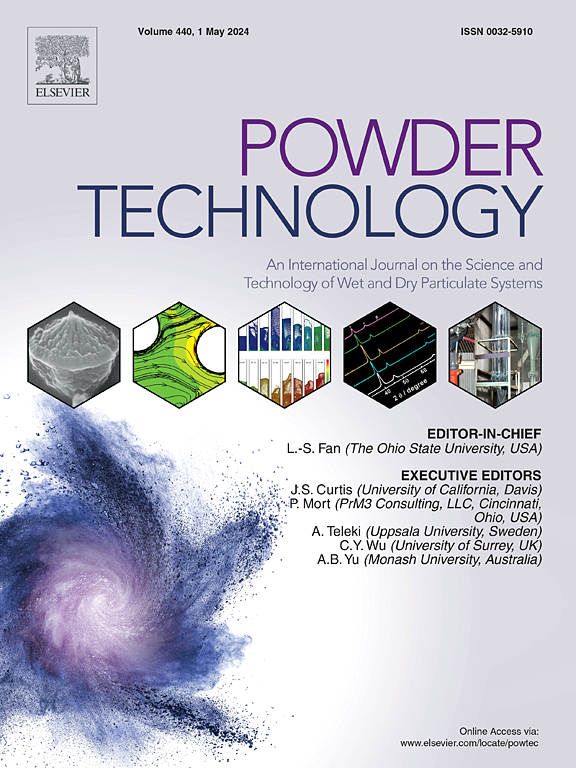描述实验室规模桨式搅拌机中粉末搅拌的流变学定律:剪切带观察和尺寸分析
IF 4.5
2区 工程技术
Q2 ENGINEERING, CHEMICAL
引用次数: 0
摘要
本研究采用系统内流变学方法,分析机械搅拌下密集流动中的粉末流动行为。为此,我们开发了一种经验法则,用于评估实验室搅拌装置中的粉末流变性,重点关注桨叶和粉末床在密流中的相互作用。该模型是一个经验法则,基于从尺寸分析和剪切带可视化中得出的类似于流变学的 μ(I) 框架。对于颗粒形状相似但尺寸不同的粉末,该模型在各种填充率下都具有良好的预测能力。这种方法解决了测量复杂粉末参数(如有效摩擦系数μeff)的难题,建立了一个实用且易于应用的模型,有助于扩大混合过程的规模,并能更好地预测施加在桨叶上的力。与波多野方程的比较表明,该模型与流变学框架非常吻合,特别是对于深粉床。更好地评估剪切带宽度和重新考虑法向应力假设可能是提高这种μ(I)流变学准确性的前进方向。本文章由计算机程序翻译,如有差异,请以英文原文为准。

A rheological law to describe powder agitation in a lab-scale paddle mixer: Shear band observation and dimensional analysis
This work adopts an in-system rheological approach to analyse powder flow behaviour in dense flows under mechanical agitation. For this purpose, an empirical law has been developed to assess powder rheology within a laboratory mixing setup, focusing on interactions between the paddles and the powder bed in dense flow. This model, is an empirical law, based on the μ(I)-rheology-like framework derived from dimensional analysis and shear band visualization. It reveals good predictive capabilities for powders of similar particle shapes but different sizes across various filling ratios. This approach addresses challenges in measuring complex powder parameters, such as the effective friction coefficient , establishing a practical and easily applicable model that facilitates the scaling up of mixing processes and allows for better anticipation of forces exerted on the paddles. Comparisons with Hatano's equation showed a good fit with the rheological framework, particularly for deep powder beds. Better evaluation of the shear band width and reconsideration of normal stress assumptions may be the way forward to improve the accuracy of this μ(I)-rheology.
求助全文
通过发布文献求助,成功后即可免费获取论文全文。
去求助
来源期刊

Powder Technology
工程技术-工程:化工
CiteScore
9.90
自引率
15.40%
发文量
1047
审稿时长
46 days
期刊介绍:
Powder Technology is an International Journal on the Science and Technology of Wet and Dry Particulate Systems. Powder Technology publishes papers on all aspects of the formation of particles and their characterisation and on the study of systems containing particulate solids. No limitation is imposed on the size of the particles, which may range from nanometre scale, as in pigments or aerosols, to that of mined or quarried materials. The following list of topics is not intended to be comprehensive, but rather to indicate typical subjects which fall within the scope of the journal's interests:
Formation and synthesis of particles by precipitation and other methods.
Modification of particles by agglomeration, coating, comminution and attrition.
Characterisation of the size, shape, surface area, pore structure and strength of particles and agglomerates (including the origins and effects of inter particle forces).
Packing, failure, flow and permeability of assemblies of particles.
Particle-particle interactions and suspension rheology.
Handling and processing operations such as slurry flow, fluidization, pneumatic conveying.
Interactions between particles and their environment, including delivery of particulate products to the body.
Applications of particle technology in production of pharmaceuticals, chemicals, foods, pigments, structural, and functional materials and in environmental and energy related matters.
For materials-oriented contributions we are looking for articles revealing the effect of particle/powder characteristics (size, morphology and composition, in that order) on material performance or functionality and, ideally, comparison to any industrial standard.
 求助内容:
求助内容: 应助结果提醒方式:
应助结果提醒方式:


